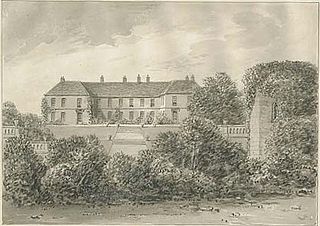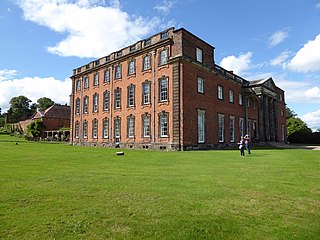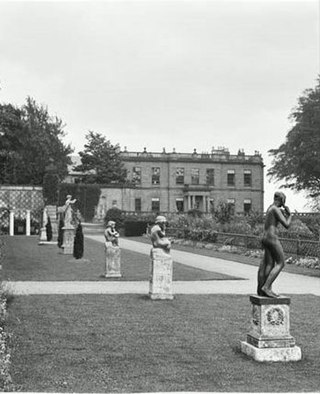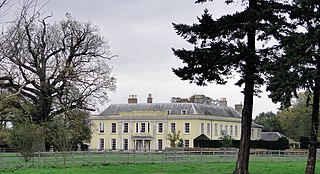
Blithfield Hall, is a privately owned Grade I listed country house in Staffordshire, England, situated some 9 miles (14 km) east of Stafford, 7 miles (11 km) southwest of Uttoxeter and 5 miles (8.0 km) north of Rugeley.

Eccleshall Castle is located in Eccleshall, Staffordshire, England. It was originally built in the 13th century. It is a Scheduled Ancient Monument and a Grade II* listed building.

Boscobel House is a Grade II* listed building in the parish of Boscobel in Shropshire. It has been, at various times, a farmhouse, a hunting lodge, and a holiday home; but it is most famous for its role in the escape of Charles II after the Battle of Worcester in 1651. Today it is managed by English Heritage.

Eccleshall is a town and civil parish in the Stafford district, in the county of Staffordshire, England. It is located seven miles northwest of Stafford, and six miles west-southwest of Stone. Eccleshall is twinned with Sancerre in France.

Fawsley is a hamlet and civil parish in West Northamptonshire, England. The population at the 2001 census was 32. At the 2011 census the population remained less than 100 and is included in the civil parish of Charwelton.

Chillington Hall is a Georgian country house near Brewood, Staffordshire, England, four miles northwest of Wolverhampton. It is the residence of the Giffard family. The Grade I listed house was designed by Francis Smith in 1724 and John Soane in 1785. The park and lake were landscaped by Capability Brown.

Condover Hall is a Grade I listed three-storey Elizabethan sandstone building, described as the grandest manor house in Shropshire, standing in a conservation area on the outskirts of Condover village, Shropshire, England, four miles south of the county town of Shrewsbury.

Broughton Castle is a medieval fortified manor house in the village of Broughton, which is about two miles southwest of Banbury in Oxfordshire, England, on the B4035 road.

Trevalyn Hall in Rossett, a Grade II* listed building, is an Elizabethan manor house near Wrexham in Wales. It was built by John Trevor in 1576. The Trevor family of Trevalyn were one of the leading families in East Denbighshire by about 1600 with numerous estates in both Flintshire and Denbighshire. The Plas Teg estate in Hope, Flintshire was also acquired by the Denbighshire branch of the family when it was purchased from a cousin by Sir John Trevor I (1563–1630) and it was he who built the present Plas Teg house in 1610.

Norbury Manor is a 15th-century Elizabethan manor house and the adjoining 13th-century stone-built medieval hall house, Norbury Hall, known as The Old Manor in Norbury near Ashbourne, Derbyshire. It is a Grade I listed building.

Oakley Hall is an early 18th century 14,929 sf mansion house at Oakley, Staffordshire, England, in the parish of Mucklestone, near the Shropshire town of Market Drayton. It is a Grade II* listed building.

Whitmore Hall is the home of the Cavenagh-Mainwaring family at Whitmore, Staffordshire. A Grade I listed building, the hall was designated a house of outstanding architectural and historical interest and is a fine example of a small Carolean style manor house.

Somerford Hall is an 18th-century Palladian style mansion house at Brewood, Staffordshire. It is a Grade II* listed building.

Somersal Herbert Hall is a privately owned timber-framed 16th-century country house at Somersal Herbert, near Ashbourne, Derbyshire, in England. It is a Grade I listed building.

Windlestone Hall is a mid-16th century Elizabethan country house, heavily rebuilt in 1821 to form a Greek revival stately home, situated near Rushyford, County Durham, England. The Hall sits within 400 acres of designed parkland. It is a Grade II* Listed building. As of 2022 it is back in private family ownership, with the surrounding estate maintained and conserved by a dedicated heritage charitable trust.

Croxall Hall is a restored and extended 16th century manor house situated in the small village of Croxall, Staffordshire. It is a Grade II* listed building.

Brockhurst and Marlston House School is a British independent and boarding preparatory school. It occupies Marlston House, a grade II* listed Elizabethan style house situated in the hamlet of Marlston and the civil parish of Bucklebury in the English county of Berkshire.

Bromwich Hall - The Manor House Museum is an important, Grade I listed, medieval domestic building built by Richard de Marnham around 1270 as the centre of his agricultural estate in West Bromwich.

Worlingham Hall is a Grade I listed Georgian country house in Worlingham, 1 mile (1.6 km) to the east of Beccles in the English county of Suffolk. The hall was built in the 18th century, possibly based on an earlier 17th century house, and as of 2014 is a country house hotel.

The North Stafford Hotel is a Grade II* listed hotel in Stoke-on-Trent, Staffordshire, England, opposite the city's railway station, also a Grade II* listed building.





















